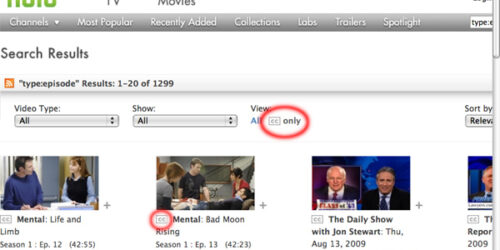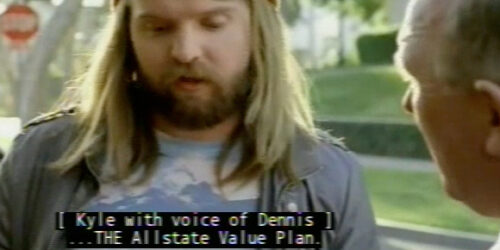Sonic allusions and cultural literacy for captioners

How should cultural allusions be closed captioned?
In a recent post, I suggested that TV episodes need to be captioned from a strong position of series awareness. When sounds intentionally reference other sounds in the series, they need to be captioned thematically. For example, if a song is identified with a major character, that song needs to be captioned in such a way that caption viewers can identify it as a recurring, thematic element. A generic caption such as “[Disco]” is not going to suffice as a caption for Gob’s trademark music, “The Final Countdown,” in Arrested Development.
The larger issue is one of cultural literacy. Wikipedia defines cultural literacy as:
the ability to converse fluently in the idioms, allusions and informal content which creates and constitutes a dominant culture. From being familiar with street signs to knowing historical references to understanding the most recent slang, literacy demands interaction with the culture and reflection of it. Knowledge of a canonical set of literature is not sufficient in and of itself when engaging with others in a society, as life is interwoven with art, expression, history and experience. Cultural literacy requires familiarity with a broad range of trivia and implies the use of that trivia in the creation of a communal language and collective knowledge. Cultural literacy stresses the knowledge of those pieces of information which content creators will assume the audience already possesses.
Captioners need to possess a deep storehouse of cultural knowledge. Otherwise, they may miss the deeper significance of the sounds they’re captioning. A seemingly simple piece of background music may actually be performing a complex act of recontextualization. TV shows are embedded in, and inscribed with elements from, the dominant culture. Even a low-brow TV show like Family Guy demands an impressive amount of cultural fluency from viewers.
If hearing viewers are tapping into a deep storehouse of knowledge to decode what they’re hearing and seeing, caption viewers need to have access to the same knowledge. If TV writers appear to be intentionally citing cultural touchstones, captioners need to cite these touchstones as well in their captions.
A delicate balance needs to be struck between citing cultural knowledge and annotating the text. Captions are not textual annotations or commentary on the text. Still, if the text is explicitly alluding (through sound) to some aspect of cultural knowledge, this knowledge needs to be cited in the captions.
Recontextualizing Peanuts in Family Guy
The Peanuts cartoon series is an American treasure. Featuring Charlie Brown and Snoopy, the comic strip ran for fifty years (until Schultz’ death in 2000) and continues in reruns today (Wikipedia). The TV specials have been passed down from parents to children. I watched the Holiday specials on TV as a kid and my own kids watched them decades later.
Family Guy has explicitly invoked the Peanuts series in multiple episodes. The Family Guy Wiki has pages on Peanuts, Snoopy, Charlie Brown, and Woodstock.
Peanuts provides an excellent case study of how cultural knowledge is captioned. There’s no denying the popularity of the series or the extent to which it is universally known to Americans. I would be surprised to find any English language captioners who are not familiar with Peanuts.
Let me offer one example of how cultural literacy impacts closed captioning. It comes from the DVD release of the Family Guy episode entitled “Brian Goes Back to College” (season 4, episode 15). In this episode, Brian is hired by The New Yorker and then fired when his employer discovers he didn’t finish college.
Granted, viewers don’t need audio cues to see that Peanuts is being spoofed here. When Brian climbs on that iconic red doghouse, culturally literate viewers get the joke. Yet the scene is not without sonic allusions to Peanuts. “No dogs allowed” is not just a sign. It’s perhaps the most memorable sound from Snoopy, Come Home, the 1972 animated film in which the sign appears and is voiced multiple times. In the film, “Snoopy and Woodstock are forced to face the challenges of a world full of signs declaring ‘No Dogs Allowed.’ Each instance – on a bus, a train, and elsewhere – is musically accented by the deep tones of Thurl Ravenscroft” (Wikipedia). A quick search turns up a number of YouTube clips from the film featuring Ravenscroft’s booming voice (e.g. this YouTube clip).
Is it possible this clip from Family Guy was intended as an homage to Ravenscroft, who died the same year (2005) the episode first aired? Ravenscroft died in May; the Family Guy episode first aired in November. The Family Guy writers would most likely be familiar with Ravenscroft’s important contributions to voice acting and animation, from singing the Grinch’s theme to lending his voice to Tony the Tiger.
The musical theme from Peanuts — i.e. the jazzy, dancing piano riff — provides the other sonic allusion in this Family Guy clip.
Together, the sonic allusions provide immediate and solid grounding for the Peanuts spoof. The sounds need to be captioned so that caption users can participate in the joke immediately, and then follow it through to its natural conclusion perched on top of the iconic red doghouse. Certainly we can agree — at the very least — that the sounds from Peanuts are more important than “(DOOR SLAMMING)”?
[Fair use notice: The videos on this site are transformative works used in good faith, in keeping with Section 107 of U.S. copyright law, and as such constitute fair use of copyrighted material. Read this site’s full fair use notice.]






I would think it also help if reviewed by a well-rounded group? It’s seems that everyone will have their areas of cultural expertise, and yet be called on to work outside that. ♪ I get by with a little help from my google ♪ [musical beatles reference]
Thanks, Bill. Google is a gift! So are these Wikis devoted to fans’ favorite TV shows and movies. While the answers to questions I have about specific sounds — e.g. what song is that? — are posted to the Wiki after the show has aired and been captioned, I think the principle is the same: Be aware of what the sound means and the work it’s doing, not just what it sounds like in isolation.